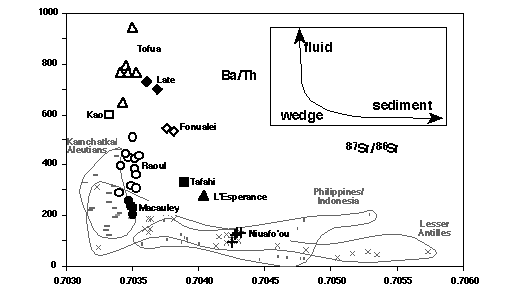
New TIMS U-Th isotope data have been obtained along with other isotope and geochemical data on a series of 25 lavas spanning the Tonga-Kermadec island arc and from the back arc island of Niua fo'ou. Excepting the back arc island, the lavas show a very restricted range in Sr, Nd and Pb isotopes. In contrast, Ba/Th ratios span a large range from 800-400 in Tonga to 400-100 in Kermadec over which 87Sr/86Sr only varies from 0.7034-0.7037. Combined, the Tonga-Kermadec data lie at the high Ba/Th, low 87Sr/86Sr end of a more global array which has been interpreted to have been dominated by mixing of partial melts of the mantle wedge with slab-derived fluids and/or subducted sediment (Fig. 1). U-Th isotope data preserve extreme U-excess in many of the lavas but some are closer to equilibrium and others exhibit Th excess. In detail, (230Th/238U) varies from 0.8-0.5 and (230Th/232Th) from 1.2-2.4 in the northern Tongan islands of Tafahi, Fonualei, Late, Kao and Tofua. Moving south along the arc into the Kermadecs, lavas from the Raoul group of islands and Macauley island lie much closer to U-Th equilibrium or show minor Th-excess with (230Th/238U) 1.1-0.8 and lower (230Th/232Th) (1.0-1.2). L'Esperance, at the southernmost end of the arc preserves greater Th-excess with (230Th/238U) = 1.2 and (230Th/232Th) = 1.1. Finally, lavas from the back arc island of Niua fo'ou preserve consistent Th-excess with (230Th/238U) = 1.2-1.5 and (230Th/232Th) = 1.0-1.3. The high Ba/Th and U-excess in the north in Tonga reflect dominance of the fluid signature relative to a highly depleted mantle wedge. Further south along the arc, the increasingly less depleted mantle wedge obscures the fluid signal leading to lower Ba/Th and higher (230Th/238U). No subduction component is seen in the back arc where Ba/Th and (230Th/232Th) ratios and moderate Th-excess are similar to those of MORB. 
Fig. 1: Plot of Ba/Th versus 87Sr/86Sr comparing the Tonga-Kermadec data in relation with that from selected other island arcs (inset shows interpretation).